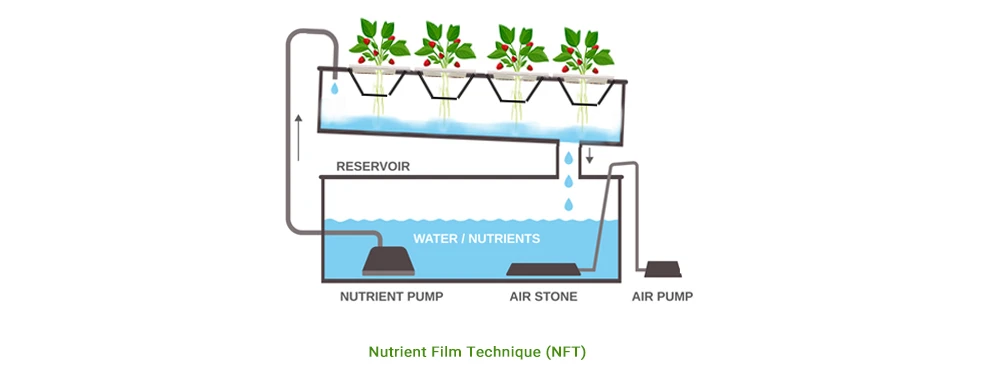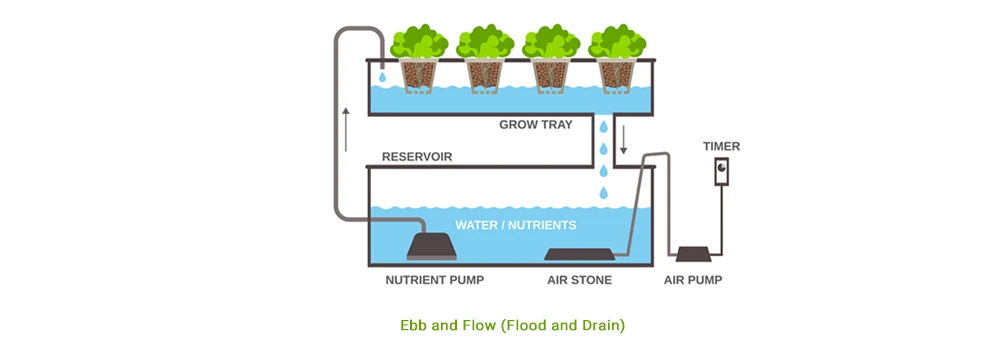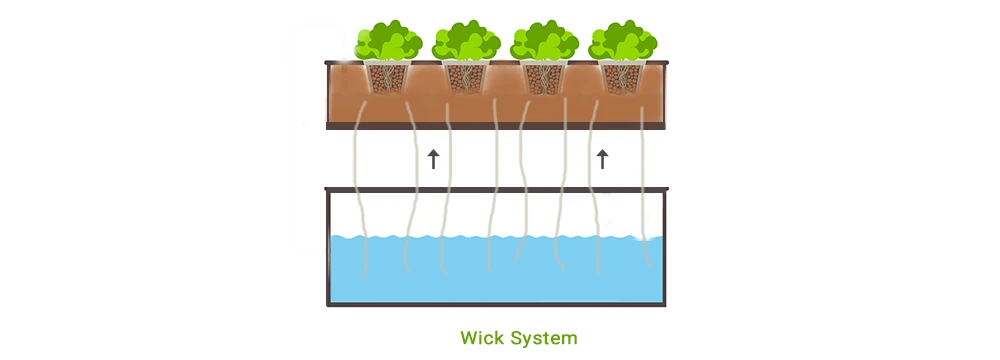Comparing 6 Basic Hydroponic Systems
Hydroponics is a soil-free method of growing plants using water, nutrients, and precise engineering. This approach promotes a more sustainable food system by optimizing resource use and plant growth.
But where do you start? With so many different hydroponic systems available, choosing the right one can feel overwhelming. In this blog, I’ll introduce you to the six basic hydroponic setups: Nutrient Film Technique (NFT), Deep Water Culture (DWC), Ebb and Flow, Wick Systems, Drip Systems, and Aeroponics. We’ll explore their key advantages, limitations, and the best applications for each to help you make an informed decision.
What is Hydroponics?
Hydroponics is a method of growing plants without soil. Instead, plants are grown in a controlled environment where their roots receive essential nutrients directly from a water-based solution. This approach is highly sustainable, using up to 90% less water than conventional farming while maximizing efficiency.
A typical hydroponic system consists of several key components: a reservoir for the nutrient solution, a growing medium (such as rockwool plugs or hydroton clay pellets), an artificial lighting system, a pH meter, and adjustment solutions to maintain optimal conditions. Thanks to this controlled environment, hydroponics enables faster plant growth and higher yields compared to traditional soil-based agriculture.
6 Basic Types of Hydroponic Systems
Hydroponic farming relies on six basic systems: Nutrient Film Technique (NFT), Deep Water Culture (DWC), Ebb and Flow, Wick Systems, Drip Systems, and Aeroponics. While there are many variations, all hydroponic methods are based on these core systems or a combination of them.
Nutrient Film Technique (NFT)
The Nutrient Film Technique (NFT) is one of the most well-known hydroponic systems. It consists of a reservoir with a submersible pump that continuously circulates a thin film of nutrient-rich water through a channel, tray, or trough where plant roots are suspended.
This system is especially popular among commercial growers due to its modular design, making it easy to scale. NFT is ideal for lightweight plants with small root systems, such as herbs, lettuce, leafy greens, and strawberries.
However, NFT systems come with two major risks: pump failure and overcrowding. If the pump stops working, the nutrient solution will no longer circulate, causing the plants to dry out quickly. If plants are spaced too closely or their roots grow too large, they can clog the channels, preventing water flow and leading to nutrient deprivation.

Deep Water Culture (DWC)
A Deep Water Culture (DWC) system suspends plants in net pots above a deep reservoir filled with oxygen-rich nutrient solution. The plant roots remain submerged in this solution, ensuring a constant supply of water, nutrients, and oxygen.
The water culture system is simple, low-cost, and low-maintenance. It is ideal for fast-growing plants like leafy greens, herbs, and lettuce. It can support some fruiting plants like tomatoes and peppers with additional structural support.
For DWC systems, oxygenation is crucial. Without enough dissolved oxygen, plant roots will suffocate. Temperature control can be difficult in DWC systems. Water temperature fluctuations can stress plants and reduce nutrient uptake.

Ebb and Flow (Flood and Drain)
The Ebb and Flow system, also called Flood and Drain, is a hydroponic method that periodically floods plant roots with nutrient-rich water before draining it away. This cycle ensures plants receive a balanced supply of water, nutrients, and oxygen.
A submerged pump connected to a timer controls the flooding and draining cycles. Plants grow in various growing mediums such as grow rocks, gravel, or granular Rockwool, which help anchor the roots and retain moisture.
Ebb and Flow systems can support a wide range of crops, including lettuce, strawberries, tomatoes, peas, beans, cucumbers, carrots, and peppers.
But ebb and flow systems require more initial investment compared to simpler hydroponic methods. A power outage or pump/timer failure can disrupt watering cycles. Additionally, Some growing mediums (like gravel, grow rocks, or perlite) dry out quickly if water is interrupted.

Wick System
The Wick System is the simplest type of hydroponics, using capillary action to transport water and nutrients from a reservoir to plant roots through a wick. The wick can be made from materials like cotton, synthetic fibers, or natural fibers. Plants grow in moisture-retaining media such as coco coir, perlite, or vermiculite.
Unlike other hydroponic systems, the Wick System doesn’t require pumps or power, making it easy to set up anywhere. It is ideal for lettuce, herbs, and other plants that don’t need a lot of water.
But wicking works slowly, so it’s not suitable for plants with high water needs, like tomatoes or cucumbers. The constant moisture can lead to fungal outbreaks and root rot, especially in organic growing media.

Drip System
A Drip System is an efficient hydroponic method that uses a pump to deliver nutrient-rich water from a reservoir to plants through a network of tubes. There are two main configurations: recovery and non-recovery. In recovery systems, excess water drains back into the reservoir and is recirculated in the next drip cycle. In a non-recovery system, excess water drains out of the growing medium and is discarded as waste.
Drip systems are widely used, especially in commercial cultivation, because they work well for nearly any type of plant. They are highly versatile and commonly used to grow pumpkins, melons, zucchinis, and many other crops.
The system can be complex and needs regular monitoring. In the recovery system, since the nutrient solution is reused, the pH and nutrient levels in the reservoir can vary and need frequent adjustments. To prevent waste and ensure plants get enough nutrients, irrigation schedules must be adjusted in a non-recovery system.

Aeroponics
An Aeroponic System suspends plants in the air, exposing their bare roots to a fine mist of nutrient-rich water. Some systems mist the roots continuously, while others spray at intervals.
An aeroponic system uses less water than any other hydroponic system since plants receive nutrients in mist form instead of being submerged. With roots exposed to high oxygen levels, plants grow more quickly than in other hydroponic methods.
Aeroponic systems work well for a variety of plants, including tomatoes, bell peppers, eggplants, lettuce and herbs, watermelons, strawberries, and ginger. However, large or heavy plants with extensive root systems, such as potatoes, are not suitable for aeroponics.
Aeroponic systems are one of the most advanced and expensive hydroponic setups. The root chamber must be cleaned frequently to prevent root diseases from spreading.

What is the best hydroponic setup for me?
Before determining the best hydroponic setup for you, let's first review a table that highlights the key differences between the six main types of hydroponic systems.
|
System |
Description |
Advantages |
Disadvantage |
Best Suited for |
|
Nutrient Film Technique (NFT)
|
Thin film of nutrient solution continuously flows over the roots
|
Efficient nutrient use; scalable |
Can clog easily; require consistent water flow |
Lettuce, herbs, lightweight plants |
|
Deep Water Culture (DWC) |
Plants are suspended in nutrient-rich water with an air pump providing oxygen |
Simple setup; low maintenance; rapid growth |
Susceptible to temperature and oxygen fluctuations |
Leafy greens, herbs, quick-growing plants |
|
Ebb and Flow (Flood and Drain) |
Periodic flooding of the root zone with nutrient solution followed by drainage |
Adjustable cycles; suitable for various plants |
Vulnerable to pump failure; requires timers |
lettuce, strawberries, tomatoes, peas, beans, cucumbers, carrots, and peppers, root vegetables |
|
Wick System |
Passive system where a wick draws nutrients to the plant roots |
Low cost, simple setup |
Limited to small plants; slower growth rate |
Small herbs, compact plants |
|
Drip System |
The nutrient solution is delivered directly to the base of each plant through drip lines |
Precise nutrient delivery; works with diverse crops |
Maintenance of emitter; risk of clogging |
Larger fruiting plants, pumpkins, melons, peppers, flowering crops |
|
Aeroponics |
Plants are suspended in air while roots are misted with nutrient solution |
Rapid growth; uses less water |
Expensive; risk of mist failure |
High-value corps |
Now, here’s a quick guide to help you decide:
- If you're a beginner, start with a Wicking System or Deep Water Culture (DWC). These systems are simple, affordable, and require less technical knowledge.
- If you have limited space, the Nutrient Film Technique (NFT) or Aeroponics might suit you, as they’re compact and can maximize vertical space.
- For a versatile and scalable option, consider the Drip System, which works with various types of plants and allows for precise nutrient delivery.
- If you’re growing larger plants, the Ebb and Flow (Flood and Drain) system provides more room for root systems and flexibility with plant size.
- If you're tech-savvy and aiming for efficiency, Aeroponics offers rapid growth and water efficiency, but it requires a higher initial investment and regular maintenance.
No matter which hydroponic system you choose, the right lighting is essential for optimal growth and success. Contact us. Our lighting experts provide tailored, effective horticulture lighting solutions to help you achieve thriving and year-round production.
FAQ
Which hydroponic system is the best for beginners?
For beginners, the Wicking System and Deep Water Culture (DWC) are excellent choices. Both systems are relatively affordable, easy to set up, and don't require a lot of technical knowledge.
What is the simplest hydroponic system?
The Wick System is the simplest hydroponic system. There are no pumps or electricity involved, making them very simple to set up and maintain.
What is the most common hydroponics system?
The Nutrient Film Technique (NFT) and Deep Water Culture (DWC) systems are two of the most common hydroponic setups. NFT is widely used in commercial growing for leafy greens like lettuce and herbs due to its simplicity and scalability. DWC is popular among hobbyists and home growers. Its relative simplicity and low cost make it accessible.
Does hydroponics require no pesticides?
Not exactly. While the need for pesticides is greatly reduced, they may still be necessary. Even in indoor setups, pests can still find their way in—hitching a ride on clothing or sneaking through small openings.

